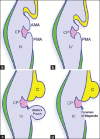Blake's pouch cyst
- PMID: 25101207
- PMCID: PMC4123264
- DOI: 10.4103/2152-7806.137533
Blake's pouch cyst
Abstract
Background: In 1900, Joseph Blake described a transient posterior evagination of the tela choroidea of the fourth ventricle in the normal 130-day old human embryo. He was the first to recognize and fully elucidate on the real nature of the foramen of Magendie as an aperture, which develops within a saccular expansion of the embryonic fourth ventricular cavity. The persistence of this temporary fourth ventricular outpouching into the postnatal period and its significance either as separate entity or as an entity within the Dandy-Walker continuum has over the years been one of the most controversial topics in both neurosurgical and neuroradiological literature.
Methods: A search of the medical literature was conducted for publications addressing the historical, embryological, and neuororadiological features as well as the clinical presentation and management of persistent Blake's pouch.
Results: The literature on the various features of Blake's pouch cyst has limited areas of consensus between various authors.
Conclusion: Blake's pouch cyst is a rare entity that is thought to belong to the Dandy-Walker continuum. It has a variable clinical presentation and when symptomatic can be treated with an endoscopic third ventriculostomy or shunting.
Keywords: Blake's pouch cyst; Dandy–Walker continuum; endoscopic; ventriculostomy.
Figures





Similar articles
-
Prospective detection and differential diagnosis of cystic posterior fossa anomalies by assessing posterior brain at 11-14 weeks.Am J Obstet Gynecol MFM. 2019 May;1(2):173-181. doi: 10.1016/j.ajogmf.2019.06.004. Epub 2019 Jun 13. Am J Obstet Gynecol MFM. 2019. PMID: 33345823
-
Blake's pouch cyst: an entity within the Dandy-Walker continuum.Neuroradiology. 2000 Apr;42(4):290-5. doi: 10.1007/s002340050888. Neuroradiology. 2000. PMID: 10872175
-
Syringomyelia associated with hydrocephalus and Blake's pouch cyst: case report.Spine (Phila Pa 1976). 2003 Jul 15;28(14):E279-83. Spine (Phila Pa 1976). 2003. PMID: 12865864
-
Abnormal or delayed development of the posterior membranous area of the brain: anatomy, ultrasound diagnosis, natural history and outcome of Blake's pouch cyst in the fetus.Ultrasound Obstet Gynecol. 2012 Mar;39(3):279-87. doi: 10.1002/uog.10138. Ultrasound Obstet Gynecol. 2012. PMID: 22081472 Review.
-
Dandy-Walker syndrome: an updated literature review.Childs Nerv Syst. 2025 May 30;41(1):194. doi: 10.1007/s00381-025-06842-0. Childs Nerv Syst. 2025. PMID: 40445443 Free PMC article. Review.
Cited by
-
The debated neuroanatomy of the fourth ventricle.J Anat. 2023 Oct;243(4):555-563. doi: 10.1111/joa.13885. Epub 2023 May 12. J Anat. 2023. PMID: 37170923 Free PMC article. Review.
-
Syringomyelia Associated with Magendie's Foramen Obstruction Due to Probably Congenital Gliomesenchymal Anomaly.NMC Case Rep J. 2025 Jun 4;12:221-226. doi: 10.2176/jns-nmc.2025-0041. eCollection 2025. NMC Case Rep J. 2025. PMID: 40556636 Free PMC article.
-
Radiological characteristics of the posterior fossa of the fetal skull and presentation of a rare case of antenatal screening for Dandy-Walker malformation using antenatal fetal ultrasound and MRI.Int J Surg Case Rep. 2024 Feb;115:109037. doi: 10.1016/j.ijscr.2023.109037. Epub 2023 Nov 20. Int J Surg Case Rep. 2024. PMID: 38184950 Free PMC article.
-
Blake Pouch: It Is Time to Revisit Classical Descriptions on the Development of the Roof of the Fourth Ventricle.Adv Tech Stand Neurosurg. 2025;55:1-16. doi: 10.1007/978-3-031-90762-3_1. Adv Tech Stand Neurosurg. 2025. PMID: 40608098 Review.
-
16p11.2 Microduplication Syndrome with Increased Fluid in the Cisterna: Coincidence or Phenotype Extension?Genes (Basel). 2023 Aug 3;14(8):1583. doi: 10.3390/genes14081583. Genes (Basel). 2023. PMID: 37628634 Free PMC article. Review.
References
-
- Arai H, Sato K. Posterior fossa cysts: Clinical, neuroradiological and surgical features. Childs Nerv Syst. 1991;7:156–64. - PubMed
-
- Barkovich AJ, Kjos BO, Norman D, Edwards MS. Revised classification of posterior fossa cysts and cystlike malformations based on the results of multiplanar MR imaging. AJR Am J Roentgenol. 1989;153:1289–300. - PubMed
-
- Barkovich AJ. Congenital malformations of the brain and skull. In: Barkovich AJ, editor. Pediatric Neuroimaging. 2nd ed. New York: Raven Press; 1994. pp. 177–275.
Publication types
LinkOut - more resources
Full Text Sources
Other Literature Sources

